Citrus: Citrus is the common term for the fruits of the genus Citrus of family Rutaceae. They are native to Australia and now cultivated all over the world in cooler climates. Common examples of fruits from Citrus are oranges, lemons, grapefruits, limes etc.
Citrus Canker
Ø Citrus canker is a bacterial disease.
Ø It is wide-spread in all the citrus growing areas.
Ø It is one of the serious disease affecting citrus plants in India, China and Japan.
Ø The disease was originated in China and now it causes large-scale destruction in citrus orchards.
Symptoms
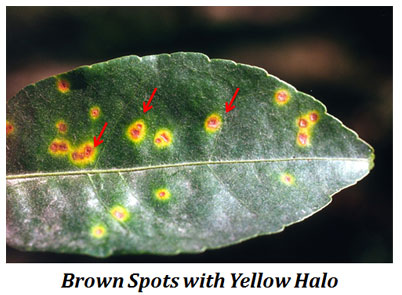
Ø The canker occurs on leaves, twigs, branches and fruits.
Ø The lesions first appear on leaves.
Ø The spots first develop on the lower surface of the leaf.
Ø In the beginning; the lesions will be small, round and watery.
Ø The spots later raised and become yellowish brown.
Ø As the disease advances, the spot becomes white or greyish and finally ruptures.
Ø The spots become rough and dark black corky.
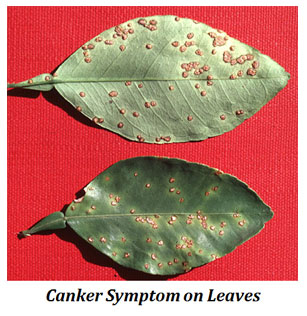
Ø In an advanced stage, small pots coalesce to large spots.
Ø Lesions are often surrounded by a yellow halo.
Ø The spotting in the petiole cause premature defoliation.
Ø Symptoms will be more prominent in young plant parts.
Ø Fruits also develop canker which is similar to that on leaves.
Ø Usually, the yellow halo is absent in fruit cancer.
Ø Only the fruit rind is affected (the pulp of the fruit is not affected).
Ø Due to the formation of corky spots on the fruits, the market value of the fruits drops.
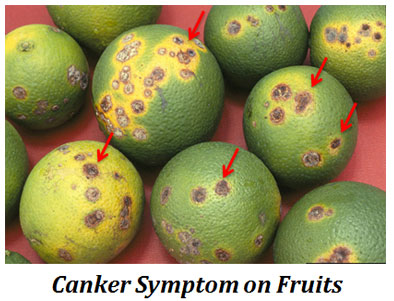
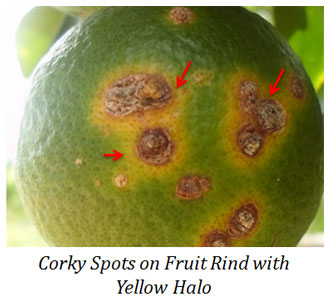
Causal Organism
Ø Citrus canker is a bacterial disease.
Ø Caused by Xanthomonas axonopodis var. citri
Ø Xanthomonas citri is a rod-shaped Gram-negative aerobic bacterium.
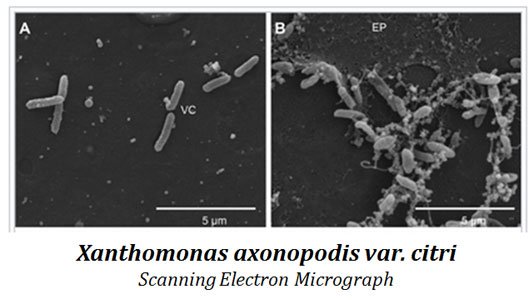
Disease cycle
Ø The bacteria enter the host by natural openings or wounds.
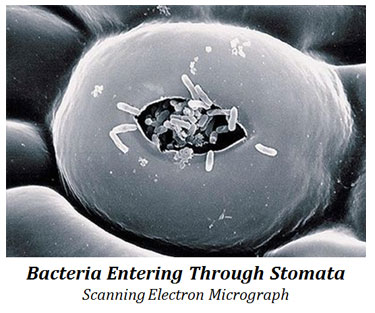
Ø Bacteria multiply in the intercellular space of the cortical region.
Ø The infection is favoured by mild temperature and humid weather.
Ø The bacteria cannot survive in the soil or dead plant parts.
Ø Thus, attacked old twigs are the main source of inoculum.
Ø The bacteria can spread by the rain-splash mechanism.
Ø Some leaf insects also reported helping in the secondary spread of the disease.
Ø Transfer of the pathogen through infected nursery stocks is very common.
Control Measures
Ø Complete elimination of canker is not possible in most of the cases.
Ø The burning of infected plants or plant parts is done to prevent the spread of the disease.
Ø The use of disease-free stocks is the best method to control the disease.
Ø Use of resistant varieties can be done
Ø Spraying plants with 1% Bordeaux mixture are found be effective.
Ø Infected fallen canker leaves and fruits are collected and burned.
Ø Proper irrigation and manure to maintain the health of the plant can also reduce the risk.
Ø Control of insects using insecticides or bio-control.
Ø Strict quarantine regulations should be following to prevent the spread of the pathogen through fruits or plant-lets.
| You may also like... | ||
|---|---|---|
| NOTES | QUESTION BANK | COMPETITIVE EXAMS. |
| PPTs | UNIVERSITY EXAMS | DIFFERENCE BETWEEN.. |
| MCQs | PLUS ONE BIOLOGY | NEWS & JOBS |
| MOCK TESTS | PLUS TWO BIOLOGY | PRACTICAL |
You might also like…
@. Cassava Mosaic Disease: Symptoms, Causal Organism and Control Measures
@. Blast of Paddy: Symptoms, Causal Organism and Control Measures
@. Enzymes in Plant Pathogen Interactions
@. Toxins in Plant Pathogen Interactions

Tqq Tqq so mach sri
thank you, keep visiting easy biology class